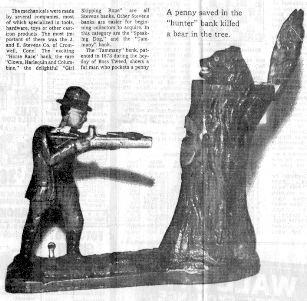THE NEW YORK TIMES, LEISURE Section,
Sunday, January 25, 1976
Those old Mechanical Banks: Pop Goes the
Penny
By CAROLE G. ROGERS
(Carole Rogers is a freelance writer who is
completing a book on the history of old penny banks.)
 Once upon a time it was fun to save
money. A dog would jump through a hoop. Horses would race around a track. A
football player would kick a ball. An eagle would feed her babies. And the
minimum deposit was only a penny.
Once upon a time it was fun to save
money. A dog would jump through a hoop. Horses would race around a track. A
football player would kick a ball. An eagle would feed her babies. And the
minimum deposit was only a penny.
Once again these days, children’s penny banks are bringing
smiles to the faces of antique buffs - and not just because they need a place
for their loose change. They respond to the charm, mechanical wizardry and
skyrocketing value of these old banks.
Most of the mechanicals are made of cast iron and were
manufactured between 1870 and the 1930’s. Almost 300 different kinds of
mechanical banks have been identified. Many more than that were patented but
seem never to have been produced.
Because the mechanicals were primarily designed to coax a
penny from children, the subjects were most often drawn from the worlds children
knew - sports, the circus, the farm, the Bible, nursery tales. A batter swings
and misses. Punch hits Judy, Jonah emerges from the mouth of the whale. A
magician makes the coin disappear under his hat.
The mechanicals were made by several companies, most of which
specialized in tools, hardware, toys or other cast-iron products. The most
important of these was the J. and E. Stevens Co. of Cromwell, Conn. The exciting
“Horse Race” bank, the rare “Clown, Harlequin and Columbine,” the
delightful “Girl Skipping Rope are all Stevens banks. Other Stevens banks are
easier for beginning collectors to acquire. In this category are the “Speaking
Dog,” and the “Tammany” bank.
The “Tammany” bank, patented in 1873 during the heyday of
Boss Tweed, shows a fat man who pockets a penny and smiles his thanks. “The
Reclining Chinaman” who held a fistful of cards was considered a very funny
bank - unless you were Chinese. Dozens of banks used the stereotype of the
hapless black man; he was dumped out of a chair, butted by a goat, kicked by a
mule.
Aside from subject matter, three factors directly affect the
desirability of a bank; its mechanical action, its rarity and its condition.
As a general rule, the more intricate the mechanical action,
the more popular the bank. Some of them, such as the Stevens banks mentioned
earlier, were manufactured year after year for a period of 30 or 40 years, and
are still relatively available today. Others not so successful in their day,
were produced for only a few years and so are more difficult to come by now.
Collectors do not have to evaluate a bank’s mechanical
action or its rarity for themselves. The man with the answers is F. H. Griffith,
the recognized expert on mechanical banks. Griffith has cataloged all the known
mechanicals and rated them in a booklet, available to collectors for $8.95 (plus
25c for first-class mail) from F. H. Griffith, P.O. Box 323, Sea Girt, N. J.
08750. Griffith has been writing a column on mechanical banks for Hobbies
magazine (Lightner Publishing Corp., 1006 S. Michigan Avenue., Chicago, Ill.
60605) for 20 years; these columns are a mine of information.
When it comes to judging the condition of a particular bank
the collector is more or less on his own, but there are certain useful criteria.
Is the mechanism in good working order? Is the original paint intact? Although a
bank with original parts all in working order is preferred, specialists can and
do repair banks. A repainted bank, however loses value.
For the collector who wants to learn more about mechanical
banks and meet other collectors, there is the Mechanical Bank Collectors Club of
America. Prospective members must present proof of ownership of five old
mechanical banks and be recommended by a fellow collector. Once accepted, the
collector has access to various club publications, including a membership list,
and may attend the annual convention where members gather to trade information
and, of course, banks. Interested collectors should write to the club’s
secretary, Mr. H. E. Mihlheim, P. O Box 128, Allegan, Michigan 49010, for
information.
Where can one find these mechanical banks? The more common
banks occasionally turn up at auctions and at antique shows and flea markets.
Others are available from dealers. But the beat source for the rarer banks is
probably other collectors who want to trade or sell duplicates. They often
publish ads in Hobbies magazine and also in the antique pages of newspapers.
